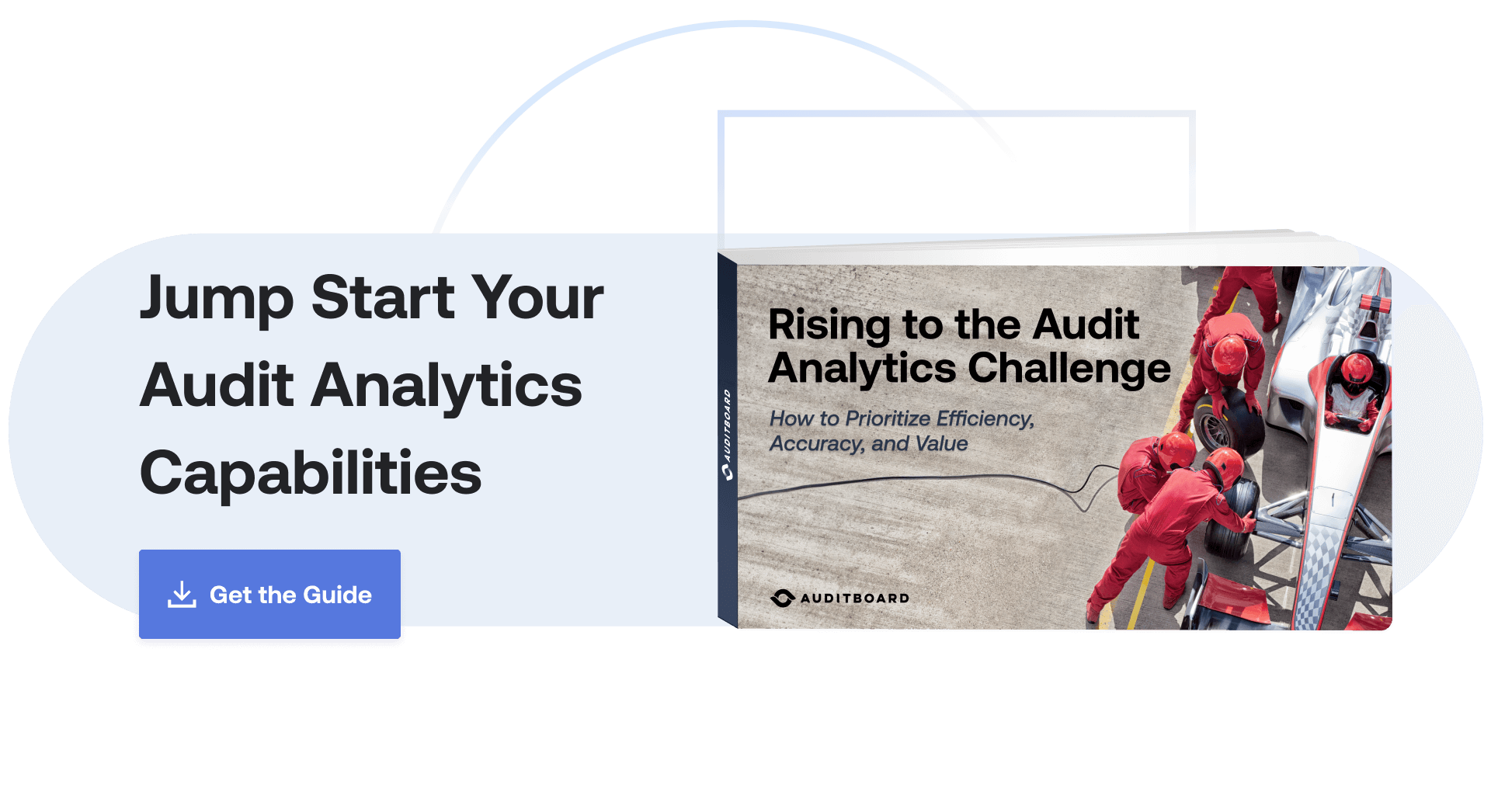
October 17, 2023 • 13 min read
Successful Audit Analytics Adoption: Overcoming the Budget Barrier Challenge



Scott Madenburg & Trevor David & Emily Oberhand
Advanced analytics — the autonomous or semi-autonomous examination of data or content using sophisticated techniques and tools — have a proven host of benefits when leveraged effectively by auditors. The successful deployment of audit analytics can lead to more accurate testing, automation of audit workflow processes, and overall improved audit efficiency.
By the numbers:
- 60% of internal audit teams use data analytics (Chartered IIA & AuditBoard’s Embracing Data Analytics: Ensuring Internal Audit’s Relevance in a Data-Led World).
- 68% of CAEs would invest in more analytics if they had the resources (The Institute of Internal Auditors’ (IIA) 2022 North American Pulse of Internal Audit Survey).
- Over 60% of SOX compliance programs use an audit management solution or GRC platform to enable compliance, and three out of four organizations are seeking opportunities to further enable automation in their program (Protiviti’s 2023 SOX Compliance Survey Report).
Yet, audit analytics adoption levels are still not entirely uniform across the industry. Most internal audit teams lack familiarity with using analytics to automate their audit and SOX workflows — and often don’t know where to start, even if they have access to an analytics solution. In AuditBoard’s Rising to the Audit Analytics Challenge: How to Prioritize Efficiency, Accuracy, and Value guide, we examine the challenges audit teams face when attempting to incorporate advanced analytics into their work processes — and why audit functions must strive to overcome these challenges to stay relevant. Download your free copy of the guide here, and continue reading to learn more about overcoming the budget barrier obstacle to enable the successful adoption of audit analytics.
Understanding the Budget Barrier Challenge
The most common obstacle blocking audit teams from effectively leveraging analytics is lack of budget for technology. This may be due to resource constraints as audit and SOX teams are being asked to reduce costs, as well as the ease and familiarity of sticking to the “status quo” of performing audits manually the way they have been done for decades. Without a technology budget, audit teams cannot access the data analytics solutions available on the market. We explore these primary analytics software options below.
- Legacy enterprise software. Legacy enterprise solutions are built using traditional, high-code computer programming, meaning there is a significant learning curve for audit users before they can use the software as intended. Consequently, businesses that invest in legacy tools typically need to hire additional audit headcount whose job is to become a “super user” of the tool, enabling the rest of the audit team to use it. As a result, legacy software solutions can be expensive investments.
- Modern data analytics. Modern data analytics refer to the cloud-based, low-code/no-code programming solutions that entered the market as superior analytics solutions designed for data scientists and business users. While modern data analytics have more features than what SOX and internal audit users typically need, they have become a popular option among audit professionals due to their graphical user interface and drag-and-drop features — which translate to greater accessibility and ease-of-use than legacy enterprise tools. At the same time, modern analytics solutions can range from expensive, “best-in-breed” solutions with many extra features to more cost-effective solutions purpose-built for the teams that use them.
As CAEs grapple with increased pressure to maintain or reduce budgets in the current economic climate, many audit teams have found themselves stuck between a rock and a hard place when it comes to investing in advanced analytics. On one hand, maintaining or reducing costs is a top priority. On the other hand, managing more audit projects and larger control populations is nearly impossible without 1) increasing headcount or 2) employing modern technology. Getting stakeholder support for investment in audit analytics is crucial, and the following section breaks down three ways to make a compelling case.
Making the Case for Allocating Budget to Advanced Analytics
As any auditor can attest, it is nearly impossible to perform a full-scope population test without technological assistance. While investing in an advanced analytics solution can be expensive, the reality is auditors need technological support to perform their day-to-day jobs effectively.
As your audit team considers how to allocate its available resources for the upcoming year, it is critical to add a low-code/no-code data analytics solution to your list of potential investments. This is especially important if your team is considering investing in a legacy enterprise solution or hiring additional headcount in the face of more compliance requirements and audit projects. The time savings and benefits of a low-code/no-code data analytics solution are far too significant to overlook.
We’ve collected three ways to make the case for investing in a low-code/no-code data analytics solution to help you manage heavier audit workloads and bigger control populations.
1. Technological Advancement.
The advancements in artificial intelligence, RPA, and low-code/no-code technology over the last five years have improved the automation capabilities of modern data analytics solutions, enabling auditors to perform full population testing with greater efficiency and accuracy than manual sample testing. In addition to being designed for usability, these advanced analytics options are available to anyone who can successfully convince their Head of Audit and SOX or Audit Transformation team to invest in them. The biggest draw of utilizing these modern analytics is that auditors can now spend substantially less time to obtain more accurate and meaningful results.
The benefits of modern data analytics are evident at the process level. Take, for example, organizing and preparing evidence for testing. This time-consuming process typically requires a significant amount of data cleansing upfront that involves the manual consolidation and deconsolidation of many spreadsheets, which is where human errors commonly occur. These spreadsheets are then sent out to reviewers for verification against a master spreadsheet, another task subject to manual error.
Modern data analytics software expedites this process significantly by automating the merging and joining of data. Removing the human element not only saves auditors precious time, but also improves data accuracy.
2. Winning the Talent War.
Because a better way to test now exists, it has become harder and harder for audit departments to justify not evolving in light of the continuing war for talent. To remain competitive and relevant, forward-thinking audit departments are focused on recruiting and retaining the next generation of audit talent — especially technologically adept talent. According to Protiviti’s 2023 Next-Gen Internal Audit Survey, fewer than six in 10 internal audit functions, on average, have access to the talent they need across 12 identified “next-gen” internal audit competencies.
As smaller audit shops compete with larger firms for promising new hires, being able to offer the experience of using a “next-gen” data analytics solution on the job is becoming a competitive advantage. The best and brightest internal auditors will be enticed by the opportunity to learn valuable technical skills that can help advance their careers in the long run.
3. Regulatory Pressure.
Regulators and other standards-setting bodies like The IIA are aware that technology to perform more accurate, full population testing now exists — and are putting pressure on CAEs to incorporate modern data analytics into their internal audit functions. Notably, The IIA is embracing these technical advances and encouraging the use of modern technologies to support internal audit processes. In fact, The IIA’s proposed Standards devote an entire section to the importance of enabling technology as a key internal audit resource. Under Domain IV. Standard 10.3, the CAE must ensure the internal audit function has appropriate technology to support the internal audit process.
Specifically, the CAE should “regularly evaluate the technology used by the internal audit function and pursue opportunities to improve effectiveness and efficiency.” In considerations for implementation and evidence of conformance, Standard 10.3 specifies examples of such technology as:
● Audit management systems.
● Process mapping applications.
● Tools that assist with data science and analytics.
● Tools that assist with communication and collaboration.
Use of these technologies is also supported by Standard 10.1 Financial Resource Management, which includes acquisition of technology resources, and Standard 8.4 External Quality Assessments (EQAs), which requires EQAs to assess the internal audit function’s use of the above-described tools and technologies. Moreover, the results of these EQAs must be reviewed by the Board of Directors, and the assessment team must include at least one individual with an active Certified Internal Auditor (CIA) designation.
In short, regulators have removed any doubt or confusion around the necessity of embracing automation technology by making specific recommendations for the types of technologies auditors should use to support their processes.
Disrupting the Status Quo to Provide Value to the Business
While resource constraints and the familiarity of traditional auditing methods may be convenient excuses not to explore the capabilities of modern data analytics, disrupting the status quo is essential for audit functions that wish to remain relevant and provide value to the business amid heightened talent, cyber, and compliance risks. Ultimately, the capacity of internal audit teams to contribute meaningfully to their organization hinges upon forward-thinking, visionary auditors and the modern technologies they harness to support their cause. By utilizing low-code/no-code analytics, audit teams can manage their risks and controls with greater accuracy and efficiency to support their business leaders in making better-informed, data-driven decisions. To learn more about the challenges behind audit analytics adoption, download the free guide Rising to the Audit Analytics Challenge: How to Prioritize Efficiency, Accuracy, and Value here.
About the authors

Scott Madenburg, CIA, CISA, CRMA, is the founder of ARCHybrid, where he serves as a market advisor, consultant, and trainer, guiding organizations and professionals in transforming their audit, risk, and compliance functions to enhance efficiency, strengthen controls, and address emerging threats. Connect with Scott on LinkedIn.

Trevor David, CPA, is a Manager of Product Solutions at AuditBoard. Trevor joined AuditBoard after six years with EY’s Advisory Services/Business Consulting practice, where he managed co-sourced and outsourced Internal Audit and SOX engagements as well as external audit engagements focused on IT general controls. Connect with Trevor on LinkedIn.

Emily Oberhand is a Senior Manager of Product Solutions at AuditBoard specializing in SOX, Audit, Risk, and ESG. Emily joined AuditBoard after seven years at PwC, where she specialized in business process and IT SOX audits as well as SOC reports in the financial services industries. Connect with Emily on LinkedIn.
You may also like to read


Top headlines that defined 2025 for internal auditors

Master your audit playbook: essential steps for internal audit teams

How the C-suite views risks and opportunities in 2026: are internal auditors poised to help?

Top headlines that defined 2025 for internal auditors

Master your audit playbook: essential steps for internal audit teams
Discover why industry leaders choose AuditBoard
SCHEDULE A DEMO




